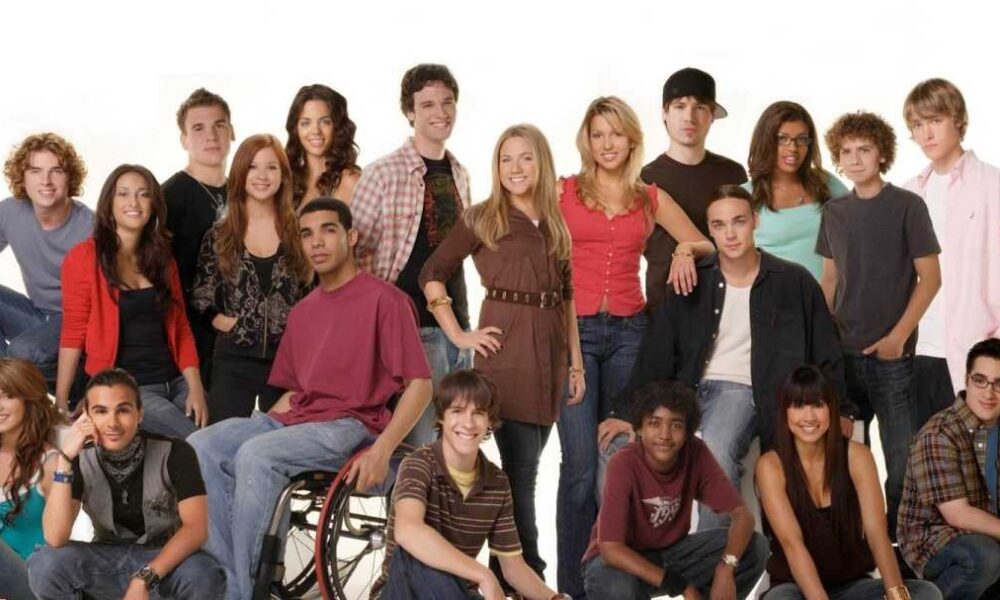If something happened at your high school, it probably also happened on Degrassi. Although the show’s “classic” era ended with Degrassi High in 1992, the Next Generation series surpassed it both in length and popularity. This was largely due to the show’s memorable cast: Toronto rapper Drake and actress Nina Dobrev both appeared as main cast members before finding considerable fame elsewhere. Most of the actors were the same age as their characters, bringing an authenticity to their onscreen awkwardness and growth. However, it is clear that many of the actors were relatively inexperienced, with scenes bringing the audience to tears from ridiculing laughter rather than powerful performances.
The long-running teen drama franchise, set and produced in and around Toronto, began with The Kids of Degrassi Street, which ran from 1979 to 1982. Its successor, Degrassi Junior High, began airing in 1987 and was directly followed by Degrassi High in 1989. The series officially concluded in 1992 and wasn’t revived until 2001, when Degrassi: The Next Generation premiered. The show was briefly continued as Degrassi: Next Class on Netflix from 2016-2017, with a new reboot of the show set to hit HBO Max in 2023. With the next iteration of the franchise imminent, it’s worthwhile to examine the impact that the show had on the television industry and beyond.
Degrassi: The Next Generation stood apart from other teen shows for its procedural format and more grounded approach to portraying teenagers. By depicting nuanced emotional conflicts and social situations, Degrassi solidified its reputation as a show that wasn’t afraid to touch on darker or more controversial subjects. While Dawson’s Creek and other American shows featured older actors with exaggerated plots and questionable realism, Degrassi: The Next Generation was entertaining without needing excessive stylization.
When I first encountered the show, it seemed drastically different than anything I’d seen before, especially since it was airing on TeenNick, the teen-aimed, mature Nickelodeon programming block that I never actually felt cool enough to watch. Degrassi: The Next Generation began airing music video promos in season 10, establishing the sustained appeal of the franchise and enticing new viewers. Several episodes of Degrassi: The Next Generation generated major attention for how they handled mature subject matters: “Accidents Will Happen” from season three, for instance, focussed on Manny (Cassie Steele) having an abortion after getting pregnant at the age of 14. American network The N refused to air the episodes, which only became available in the United States in 2006, two years after their initial release in Canada. While the U.S. clung to shiny, happy-go-lucky teen programming, Canada wasn’t afraid to tell it like it was. In season 10, Adam Torres (Jordan Todosey) was introduced, becoming one of the first transgender characters on scripted Canadian television. Degrassi High: School’s Out!, a television film that served as the finale for Degrassi High, even featured the first use of the word “fuck” on Canadian primetime television.
Degrassi has always been relatively self-contained, which has led to the creation of many memes and jokes in the years since it went off-air. Despite the questionable fashion, gritty acting, and excessive school bands on the shows over the years, the series’ realism has allowed it to endure longer than other teen-oriented shows such as Riverdale. While the lengthy duration of The Next Generation forced certain plots to get recycled—like teen pregnancy, car crashes, makeovers, and fights—they never became trivialized or glamourized. Unlike other soulless reboots, reviving Degrassi feels loyal to the trajectory of the franchise. The show’s theme song rings true: Whatever it takes, Degrassi will make it through.









